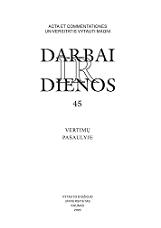Autentiško sąmonės atvirumo beieškant. Šarūno saukos ir algimanto švėgždos vizualumo refleksijos
In search of an authentic openness of consciousness. Reflection in the Visual Discourse of Sarunas Sauka and Algimantas Svegzda
Author(s): Darius KlibavičiusSubject(s): Philosophy
Published by: Vytauto Didžiojo Universitetas
Keywords: search; authentic; openness; consciousness; Reflection; Visual; Discourse; Sarunas; Sauka; Algimantas; Svegzda;
Summary/Abstract: The article deals with the problem of consciousness, which is described by the criteria of authenticity. The main methodological opposition is concentrated on the categories of cynicism and sincerity, with the help of which visual discourses of painters Šarûnas Sauka (born in 1958) and Algimantas Jonas Švëgþda (1941-1996) are analysed. As the visual discourses described in the article express existential attitudes, they are interpreted by the means of philosophical reflection. Methodologically cynicism is characterised as enlightened false consciousness, while sincerity is described as enlightened “right” consciousness. In the article cynicism is presented as purely theoretical and far away from reality, aesthetised, self-aimed as well as a position of discontent and disillusion. Sincerity is introduced as the way of immediate and personal relation fulfillment and direction of consciousness into meditation practice. Cynicism is the substitutional form of openness closely related to the destructive strategies of postmodernism and solely relation sincerity is the only authentically possible form of consciousness openness. From the point of view of discourse, cynicism actualises itself by widely discussing the problem of identification, i.e. by numerous narratives of self-portrait multiplications and the analysis of corporeality. Meanwhile sincerity serves as a quiet method of world contemplation; moreover it is based on experience rather than theoretical position. From this viewpoint priority is given not to gnoseological consciousness (enlightened and false cognition), but to ontological consciousness (present in the light of revelation). On the intersection of two different paradigms it becomes clear that Š.Sauka creates ugly beauty purposely and A.Švëgþda restrains himself from the action and does not create beauty at all. The article is based on the works of P.Sloterdijk, M.Buber, T.Bewes and others.
Journal: Darbai ir dienos
- Issue Year: 2005
- Issue No: 41
- Page Range: 81-94
- Page Count: 14
- Language: Lithuanian

